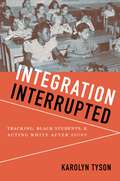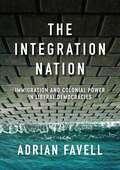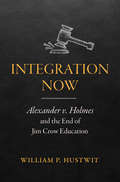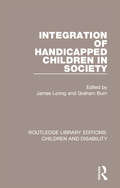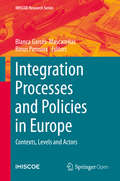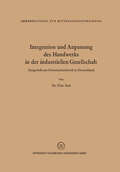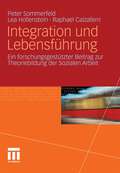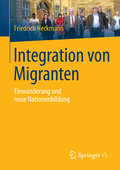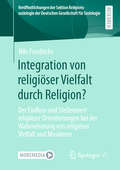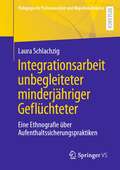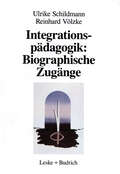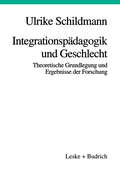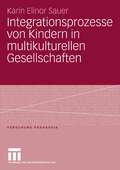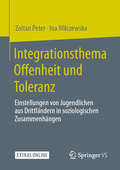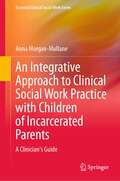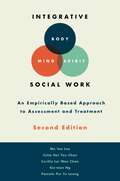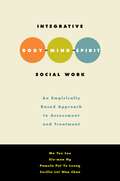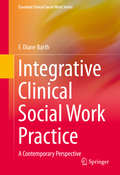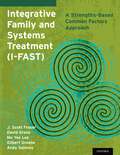- Table View
- List View
Integration Interrupted: Tracking, Black Students, and Acting White after Brown
by Karolyn TysonAn all-too-popular explanation for why black students aren't doing better in school is their own use of the "acting white" slur to ridicule fellow blacks for taking advanced classes, doing schoolwork, and striving to earn high grades. Carefully reconsidering how and why black students have come to equate school success with whiteness, Integration Interrupted argues that when students understand race to be connected with achievement, it is a powerful lesson conveyed by schools, not their peers. Drawing on over ten years of ethnographic research, Karolyn Tyson shows how equating school success with "acting white" arose in the aftermath of Brown v. Board of Education through the practice of curriculum tracking, which separates students for instruction, ostensibly by ability and prior achievement. Only in very specific circumstances, when black students are drastically underrepresented in advanced and gifted classes, do anxieties about "the burden of acting white" emerge. Racialized tracking continues to define the typical American secondary school, but it goes unremarked, except by the young people who experience its costs and consequences daily. The rich narratives in Integration Interrupted throw light on the complex relationships underlying school behaviors and convincingly demonstrate that the problem lies not with students, but instead with how we organize our schools.
Integration Interrupted: Tracking, Black Students, and Acting White after Brown
by Karolyn TysonAn all-too-popular explanation for why black students aren't doing better in school is their own use of the "acting white" slur to ridicule fellow blacks for taking advanced classes, doing schoolwork, and striving to earn high grades. Carefully reconsidering how and why black students have come to equate school success with whiteness, Integration Interrupted argues that when students understand race to be connected with achievement, it is a powerful lesson conveyed by schools, not their peers. Drawing on over ten years of ethnographic research, Karolyn Tyson shows how equating school success with "acting white" arose in the aftermath of Brown v. Board of Education through the practice of curriculum tracking, which separates students for instruction, ostensibly by ability and prior achievement. Only in very specific circumstances, when black students are drastically underrepresented in advanced and gifted classes, do anxieties about "the burden of acting white" emerge. Racialized tracking continues to define the typical American secondary school, but it goes unremarked, except by the young people who experience its costs and consequences daily. The rich narratives in Integration Interrupted throw light on the complex relationships underlying school behaviors and convincingly demonstrate that the problem lies not with students, but instead with how we organize our schools.
The Integration Nation: Immigration and Colonial Power in Liberal Democracies (Immigration and Society)
by Adrian FavellThe notion of ‘immigrant integration’ is used everywhere – by politicians, policy makers, journalists and researchers – as an all-encompassing framework for rebuilding ‘unity from diversity’ after large-scale immigration. Promising a progressive middle way between backward-looking ideas of assimilation and the alleged fragmentation of multiculturalism, ‘integration’ has become the default concept for states scrambling to deal with global refugee management and the persistence of racial disadvantage. Yet ‘integration’ is the continuance of a long-standing colonial development paradigm. It is how majority-white liberal democracies absorb and benefit from mass migration while maintaining a hierarchy of race and nationality – and the global inequalities it sustains. Immigrant integration sits at the heart of the neo-liberal racial capitalism of recent decades, in which tight control of nation-building and bordering selectively enables some citizens to enjoy the mobilities of a globally integrating world, as other populations are left behind and locked out. Subjecting research and policy on immigrant integration to theoretical scrutiny, The Integration Nation offers a fundamental rethink of a core concept in migration, ethnic and racial studies in the light of the challenge posed by decolonial theory and movements.
The Integration Nation: Immigration and Colonial Power in Liberal Democracies (Immigration and Society)
by Adrian FavellThe notion of ‘immigrant integration’ is used everywhere – by politicians, policy makers, journalists and researchers – as an all-encompassing framework for rebuilding ‘unity from diversity’ after large-scale immigration. Promising a progressive middle way between backward-looking ideas of assimilation and the alleged fragmentation of multiculturalism, ‘integration’ has become the default concept for states scrambling to deal with global refugee management and the persistence of racial disadvantage. Yet ‘integration’ is the continuance of a long-standing colonial development paradigm. It is how majority-white liberal democracies absorb and benefit from mass migration while maintaining a hierarchy of race and nationality – and the global inequalities it sustains. Immigrant integration sits at the heart of the neo-liberal racial capitalism of recent decades, in which tight control of nation-building and bordering selectively enables some citizens to enjoy the mobilities of a globally integrating world, as other populations are left behind and locked out. Subjecting research and policy on immigrant integration to theoretical scrutiny, The Integration Nation offers a fundamental rethink of a core concept in migration, ethnic and racial studies in the light of the challenge posed by decolonial theory and movements.
Integration Now: Alexander v. Holmes and the End of Jim Crow Education
by William P. HustwitRecovering the history of an often-ignored landmark Supreme Court case, William P. Hustwit assesses the significant role that Alexander v. Holmes (1969) played in integrating the South's public schools. Although Brown v. Board of Education has rightly received the lion's share of historical analysis, its ambiguous language for implementation led to more than a decade of delays and resistance by local and state governments. Alexander v. Holmes required "integration now," and less than a year later, thousands of children were attending integrated schools. Hustwit traces the progression of the Alexander case to show how grassroots activists in Mississippi operated hand in glove with lawyers and judges involved in the litigation. By combining a narrative of the larger legal battle surrounding the case and the story of the local activists who pressed for change, Hustwit offers an innovative, well-researched account of a definitive legal decision that reaches from the cotton fields of Holmes County to the chambers of the Supreme Court in Washington.
Integration of Handicapped Children in Society (Routledge Library Editions: Children and Disability)
by James Loring Graham BurnFirst published in 1975, this book looks at the place of children with handicaps in society, at that time. It argues that in the thirty years previous, a great deal of progress was made in the field of rehabilitation but that the separation between handicapped people and the community was still a challenge. A strong range of contributors discuss approaches to the problem focusing on education, employment, and daily life. Topics covered include the social aspects of integration, through the problems of the multiple-handicapped child, to a survey of disabled students at universities and polytechnics in Great Britain.
Integration of Handicapped Children in Society (Routledge Library Editions: Children and Disability #9)
by James Loring Graham BurnFirst published in 1975, this book looks at the place of children with handicaps in society, at that time. It argues that in the thirty years previous, a great deal of progress was made in the field of rehabilitation but that the separation between handicapped people and the community was still a challenge. A strong range of contributors discuss approaches to the problem focusing on education, employment, and daily life. Topics covered include the social aspects of integration, through the problems of the multiple-handicapped child, to a survey of disabled students at universities and polytechnics in Great Britain.
Integration Processes and Policies in Europe: Contexts, Levels and Actors (IMISCOE Research Series)
by Blanca Garcés-Mascareñas Rinus PenninxIn this open access book, experts on integration processes, integration policies, transnationalism, and the migration and development framework provide an academic assessment of the 2011 European Agenda for the Integration of Third-Country Nationals, which calls for integration policies in the EU to involve not only immigrants and their society of settlement, but also actors in their country of origin. Moreover, a heuristic model is developed for the non-normative, analytical study of integration processes and policies based on conceptual, demographic, and historical accounts. The volume addresses three interconnected issues: What does research have to say on (the study of) integration processes in general and on the relevance of actors in origin countries in particular? What is the state of the art of the study of integration policies in Europe and the use of the concept of integration in policy formulation and practice? Does the proposal to include actors in origin countries as important players in integration policies find legitimation in empirical research?A few general conclusions are drawn. First, integration policies have developed at many levels of government: nationally, locally, regionally, and at the supra-national level of the EU. Second, a multitude of stakeholders has become involved in integration as policy designers and implementers. Finally, a logic of policymaking—and not an evidence-based scientific argument—can be said to underlie the European Commission’s redefinition of integration as a three-way process.This book will appeal to academics and policymakers at international, European, national, regional, and local levels. It will also be of interest to graduate and master-level students of political science, sociology, social anthropology, international relations, criminology, geography, and history.
Integration und Anpassung des Handwerks in der industriellen Gesellschaft: Dargestellt am Schreinerhandwerk in Deutschland (Abhandlungen zur Mittelstandsforschung #16)
by Fritz SackIntegration und Lebensführung: Ein forschungsgestützter Beitrag zur Theoriebildung der Sozialen Arbeit
by Peter Sommerfeld Lea Hollenstein Raphael CalzaferriSoziale Arbeit bildet sich am Integrationsproblem der modernen, demokratisch verfassten Gesellschaften. Diese leitende gesellschaftstheoretische Bestimmung der Sozialen Arbeit führt zur Frage nach dem dynamischen Zusammenspiel von Individuen und sozialen Systemen, in das die Praxis der Sozialen Arbeit interveniert. Zusammen mit dem Begriff der Lebensführung wird eine begriffliche Grundlage für die Theoriebildung der Sozialen Arbeit skizziert, die als Grundlage für eine empirische Studie zu Re-Integrationsprozessen nach stationären Aufenthalten (in der Psychiatrie, dem Gefängnis, dem Frauenhaus) verwendet wurde. Mittels eines innovativen Mixed-Methods-Designs, das biografische und klinische Interviews mit einem quantitativen Monitoring-Verfahren kombiniert hat, wurden 16 Fälle über einen Zeitraum von bis zu einem Jahr nach der Entlassung begleitet. Die Forschungsergebnisse zeichnen ein reichhaltiges und tiefgehendes Bild der systemischen, psycho-sozialen Dynamik der menschlichen Lebensführung in „sozialen Figurationen“.
Integration von Migranten: Einwanderung und neue Nationenbildung
by Friedrich HeckmannDeutschland hat sich verändert. Migration und Integration sind zu konstitutiven Merkmalen seiner Sozial- und Gesellschaftsstruktur geworden. Mit gegenwärtigen und in Zukunft zu erwartenden neuen Zyklen von Einwanderung wird Integration von Migranten zur gesellschaftlichen Daueraufgabe. Dieses Buch hat zum einen das Ziel, gesellschaftliche Wirklichkeit von Integrationsprozessen darzustellen; zum anderen sozialwissenschaftliche Theorien zur Erklärung der Entstehung und des Verlaufs von Integrationsprozessen vorzustellen sowie praktische Maßnahmen zu diskutieren, diese Prozesse mittels Integrationspolitik zu beeinflussen.
Integration von religiöser Vielfalt durch Religion?: Der Einfluss und Stellenwert religiöser Orientierungen bei der Wahrnehmung von religiöser Vielfalt und Muslimen (Veröffentlichungen der Sektion Religionssoziologie der Deutschen Gesellschaft für Soziologie)
by Nils FriedrichsDas Buch untersucht die Strukturen hinter den Einstellungen zu religiöser Vielfalt und zu Muslimen in Deutschland und geht der Frage nach, wie Religiosität diese Einstellungen beeinflusst. Es zeigt sich, dass Toleranz als eigenständige Haltung lediglich existiert, wenn es um Religionsvielfalt im Allgemeinen geht, nicht jedoch in Bezug auf Muslime. Religiosität wirkt dabei äußerst ambivalent. Hochreligiöse neigen zur Betonung des Wahrheitsanspruchs ihrer Religion, Atheisten sind tendenziell religionskritisch, weshalb beide Gruppen Muslime und religiöse Vielfalt eher negativ bewerten. Ist die Religiosität nicht dogmatisch, sind andere Faktoren wie z. B. Deprivation, politische Einstellungen oder Intergruppenkontakt wichtiger.
Integrationsarbeit unbegleiteter minderjähriger Geflüchteter: Eine Ethnografie über Aufenthaltssicherungspraktiken (Pädagogische Professionalität und Migrationsdiskurse)
by Laura SchlachzigDie Studie untersucht Aufenthaltssicherungspraktiken von unbegleiteten minderjährigen Geflüchteten. Nach einem abgelehnten Asylantrag dominiert das Leistungsprinzip, dass ein sicherer Aufenthalt mit Teilhabemöglichkeiten und einem Mehr an Freiheit über „Integration“ selbst zu erarbeiten ist. Es geht dabei vordergründig um die individuelle Einsatzbereitschaft, Kapitalien gewinnbringend auf dem deutschen Arbeitsmarkt einzusetzen, sich entlang eines Fähigkeitsregimes selbst zu optimieren und die Folgen von aufenthaltsrechtlichen Entscheidungen selbst zu verantworten. Institutionen der Jugendhilfe wirken im Prozess der Aufenthaltssicherung ermöglichend und begrenzend zugleich.
Integrationspädagogik: Berufliche Werdegänge von Erzieherinnen in Kindergartengruppen für behinderte und nichtbehinderte Kinder
by Ulrike SchildmannIntegrationspädagogik und Geschlecht: Theoretische Grundlegung und Ergebnisse der Forschung
by Ulrike SchildmannIntegrationsprozesse von Kindern in multikulturellen Gesellschaften (Forschung Pädagogik)
by Karin Elinor SauerKarin Elinor Sauer vergleicht Integrationsprozesse von Migrantenkindern in Baden-Württemberg und Kalifornien. Es wird einerseits eine Außenperspektive auf die gesellschaftlichen Hintergründe eingenommen, andererseits eine Innenperspektive, die die Sicht der Kinder und deren Bedeutung für Integration reflektiert. Dabei zeigt sich, wie die Integration auf verschiedenen Wegen und in verschiedenen Kontexten von den Kindern selbst mitgestaltet wird.
Integrationsthema Offenheit und Toleranz: Einstellungen von Jugendlichen aus Drittländern in soziologischen Zusammenhängen
by Zoltan Peter Ina WilczewskaZoltan Peter und Ina Wilczewska untersuchen in ihrer empirischen Studie 1000 Jugendliche quantitativ und qualitativ in Hinblick auf ihre Offenheit und Toleranz. Befragt werden Jugendliche, die in einem Drittstaat geboren wurden und in Österreich leben. 80% der befragten Jugendlichen zeigen sich als proeuropäisch eingestellt, 60 Prozent sind es in besonders starkem Ausmaß. Bei 20-30% besteht hingegen leichter bis stärkerer Nachhol- und Unterstützungsbedarf. Ihnen mangelt es an Offenheit gegenüber liberalen Werten und Grundrechten. Sie neigen beträchtlich zu Vorurteilen, 5% erweisen sich – besonders in Religionsfragen – als sehr intolerant. Im Kern zeigt die Studie, dass der Anteil der jungen eingewanderten Bevölkerung, der demokratiefeindliche Einstellungen erkennen lässt, bei weitem nicht so hoch ist, wie die öffentliche Meinung vermuten lassen würde.
An Integrative Approach to Clinical Social Work Practice with Children of Incarcerated Parents: A Clinician's Guide (Essential Clinical Social Work Series)
by Anna Morgan-MullaneThis book is an essential clinician's guide to understanding, unpacking, treating, and healing individual, familial, and communal wounds associated with parental incarceration. Readers gain familiarity with integrative micro and macro healing techniques and modalities that are currently being utilized as anti-racist, anti-oppressive, and innovative practices. They also develop an understanding of and deeper unpacking of their own biases within the therapeutic relationship. The book offers an extensive overview of clinical practice models such as trauma-focused cognitive behavioral therapy, narrative therapy, and relational and attachment-based therapy for treating trauma symptoms associated with children of incarcerated parents, their families, and their surrounding communities. The author provides guidance on healing complex trauma through phase-oriented, multimodal, and skill-focused treatment approaches, with emphasis on strengthening one's own narrative of power and pain while building community in supportive spaces. Among the topics covered:Why Criminal Justice Is Relevant to All Clinical PractitionersImpact of Secondary Incarceration: Collateral Consequences for Children and FamiliesPsychosocial Stressors for Children of Incarcerated Parents: Conspiracy of Silence and Ambiguous LossSupervision and the Therapeutic Alliance: Critical Consciousness and Anti-racist Clinical Training and UndoingClinical Partnership: Application of Dismantling Anti-Blackness Through Anti-oppressive Practice and Critical ConsciousnessAn Integrative Approach to Clinical Social Work Practice with Children of Incarcerated Parents enhances therapeutic relationships for social workers, teaches innovative clinical practices most effective for this population, and offers a comprehensive discussion and understanding of the complex traumas faced both historically and presently by children and families impacted by the criminal justice system. Although designed to inspire and train social workers, the guide has significantly wide-ranging application for mental health and medical providers and other clinicians interested in enhancing their work with children and families impacted by the criminal justice system in diverse clinical practice settings. Lay practitioners and policymakers within government and not-for-profit settings also will find the book of interest.
Integrative Body-Mind-Spirit Social Work: An Empirically Based Approach to Assessment and Treatment
by Mo Yee Lee Celia C. Chan Cecilia L. Chan Siu-man Ng Pamela P. LeungIntegrative therapy focuses on the mind-body-spirit relationship, recognizes spirituality as a fundamental domain of human existence, acknowledges and utilizes the mind's power as well as the body's, and reaches beyond self-actualization or symptom reduction to broaden a perception of self that connects individuals to a larger sense of themselves and to their communities. When it was published in 2009, Integrative Body-Mind-Spirit Social Work was the first book to strongly connect Western therapeutic techniques with Eastern philosophy and practices, while also providing a comprehensive and pragmatic agenda for social work, and mental health professionals. This breakthrough text, written by a cast of highly regarded researchers from both Asia and America, presented a holistic, therapeutic approach that ties Eastern philosophy and practical techniques to Western forms of therapy in order to help bring about positive, transformative changes in individuals and families. This second features a major reorganization of Part III: Applications and Treatment Effectiveness, renamed to "Evidence-informed Translational Practice and Evidence." Based on systematic reviews of Integrative body-mind-spirit practices, Part III provides a "resource guide" of different types of integrative practices used in diverse health and mental health conditions. A new companion website includes streaming video clips showing demonstrations of the BMS techniques described in the book and worksheets and client resources/handouts. Here, the authors provide a pragmatic, step-by-step description of assessment and treatment techniques that employ an integrative, holistic perspective. They begin by establishing the conceptual framework of integrative body-mind-spirit social work, then expertly describe, step-by-step, assessment and treatment techniques that utilize integrative and holistic perspectives. Numerous case studies demonstrate the approach in action, such as one with breast cancer patients who participated in body-mind-spirit and social support groups and another in which trauma survivors used meditation to get onto a path of healing. These examples provide solid empirical evidence that integrative body-mind-spirit social work is indeed a practical therapeutic approach in bringing about tangible changes in clients. The authors also discuss ethical issues and give tips for learning integrative body-mind-spirit social work. Professionals in social work, psychology, counseling, and nursing, as well as graduate students in courses on integral, alternative, or complementary clinical practice will find this a much-needed resource that complements the growing interest in alternatives to traditional Western psychotherapy.
Integrative Body-Mind-Spirit Social Work: An Empirically Based Approach to Assessment and Treatment
by Mo Yee Lee Celia C. Chan Cecilia L. Chan Siu-man Ng Pamela P. LeungIntegrative therapy focuses on the mind-body-spirit relationship, recognizes spirituality as a fundamental domain of human existence, acknowledges and utilizes the mind's power as well as the body's, and reaches beyond self-actualization or symptom reduction to broaden a perception of self that connects individuals to a larger sense of themselves and to their communities. When it was published in 2009, Integrative Body-Mind-Spirit Social Work was the first book to strongly connect Western therapeutic techniques with Eastern philosophy and practices, while also providing a comprehensive and pragmatic agenda for social work, and mental health professionals. This breakthrough text, written by a cast of highly regarded researchers from both Asia and America, presented a holistic, therapeutic approach that ties Eastern philosophy and practical techniques to Western forms of therapy in order to help bring about positive, transformative changes in individuals and families. This second features a major reorganization of Part III: Applications and Treatment Effectiveness, renamed to "Evidence-informed Translational Practice and Evidence." Based on systematic reviews of Integrative body-mind-spirit practices, Part III provides a "resource guide" of different types of integrative practices used in diverse health and mental health conditions. A new companion website includes streaming video clips showing demonstrations of the BMS techniques described in the book and worksheets and client resources/handouts. Here, the authors provide a pragmatic, step-by-step description of assessment and treatment techniques that employ an integrative, holistic perspective. They begin by establishing the conceptual framework of integrative body-mind-spirit social work, then expertly describe, step-by-step, assessment and treatment techniques that utilize integrative and holistic perspectives. Numerous case studies demonstrate the approach in action, such as one with breast cancer patients who participated in body-mind-spirit and social support groups and another in which trauma survivors used meditation to get onto a path of healing. These examples provide solid empirical evidence that integrative body-mind-spirit social work is indeed a practical therapeutic approach in bringing about tangible changes in clients. The authors also discuss ethical issues and give tips for learning integrative body-mind-spirit social work. Professionals in social work, psychology, counseling, and nursing, as well as graduate students in courses on integral, alternative, or complementary clinical practice will find this a much-needed resource that complements the growing interest in alternatives to traditional Western psychotherapy.
Integrative Body-Mind-Spirit Social Work: An Empirically Based Approach to Assessment and Treatment
by Mo Yee Lee Siu-Man Ng Pamela Pui Leung Cecilia Lai Chan Pamela LeungIn recent years, interest in non-Western curative techniques among Americans has grown by leaps and bounds. Integrative Body-Mind-Spirit Social Work is the first book to strongly connect Western therapeutic techniques with Eastern philosophy and practices, while also providing a comprehensive and pragmatic agenda for social work, and mental health professionals. This breakthrough text, written by a cast of highly regarded researchers from both Asia and America, presents a holistic, therapeutic approach that ties Eastern philosophy and practical techniques to Western forms of therapy in order to help bring about positive, transformative changes in individuals and families. Integrative therapy focuses on the mind-body-spirit relationship, recognizes spirituality as a fundamental domain of human existence, acknowledges and utilizes the mind's power as well as the body's, and reaches beyond self-actualization or symptom reduction to broaden a perception of self that connects individuals to a larger sense of themselves and to their communities. Here, the authors provide a pragmatic, step-by-step description of assessment and treatment techniques that employ an integrative, holistic perspective. They begin by establishing the conceptual framework of integrative body-mind-spirit social work, then expertly describe, step-by-step, assessment and treatment techniques that utilize integrative and holistic perspectives. Several case studies demonstrate the approach in action, such as one with breast cancer patients who participated in body-mind-spirit and social support groups and another in which trauma survivors used meditation to get onto a path of healing. These examples provide solid empirical evidence that integrative body-mind-spirit social work is indeed a practical therapeutic approach in bringing about tangible changes in clients. The authors also discuss ethical issues and give tips for learning integrative body-mind-spirit social work. Professionals in social work, psychology, counseling, and nursing, as well as graduate students in courses on integral, alternative, or complementary clinical practice will find this a much-needed resource that complements the growing interest in alternatives to traditional Western psychotherapy.
Integrative Body-Mind-Spirit Social Work: An Empirically Based Approach to Assessment and Treatment
by Mo Yee Lee Siu-Man Ng Pamela Pui Leung Cecilia Lai Chan Pamela LeungIn recent years, interest in non-Western curative techniques among Americans has grown by leaps and bounds. Integrative Body-Mind-Spirit Social Work is the first book to strongly connect Western therapeutic techniques with Eastern philosophy and practices, while also providing a comprehensive and pragmatic agenda for social work, and mental health professionals. This breakthrough text, written by a cast of highly regarded researchers from both Asia and America, presents a holistic, therapeutic approach that ties Eastern philosophy and practical techniques to Western forms of therapy in order to help bring about positive, transformative changes in individuals and families. Integrative therapy focuses on the mind-body-spirit relationship, recognizes spirituality as a fundamental domain of human existence, acknowledges and utilizes the mind's power as well as the body's, and reaches beyond self-actualization or symptom reduction to broaden a perception of self that connects individuals to a larger sense of themselves and to their communities. Here, the authors provide a pragmatic, step-by-step description of assessment and treatment techniques that employ an integrative, holistic perspective. They begin by establishing the conceptual framework of integrative body-mind-spirit social work, then expertly describe, step-by-step, assessment and treatment techniques that utilize integrative and holistic perspectives. Several case studies demonstrate the approach in action, such as one with breast cancer patients who participated in body-mind-spirit and social support groups and another in which trauma survivors used meditation to get onto a path of healing. These examples provide solid empirical evidence that integrative body-mind-spirit social work is indeed a practical therapeutic approach in bringing about tangible changes in clients. The authors also discuss ethical issues and give tips for learning integrative body-mind-spirit social work. Professionals in social work, psychology, counseling, and nursing, as well as graduate students in courses on integral, alternative, or complementary clinical practice will find this a much-needed resource that complements the growing interest in alternatives to traditional Western psychotherapy.
Integrative Clinical Social Work Practice: A Contemporary Perspective (Essential Clinical Social Work Series)
by F. Diane BarthIn recent history the practice of medicine and mental health has been increasingly eclectic as more and more practitioners harness seemingly disparate therapies and techniques to arrive at clinical breakthroughs. But while social work professionals have been involved in integrative practice informally and intuitively for years, resources to bring structure to this therapeutic concept have been few and far between.In response, Integrative Social Work Practice offers innovative ways of conceptualizing cases, communicating with clients and making better therapeutic use of client individuality. Rich in research, evidence-based and clinical material from a variety of settings, the book begins with the basic organizing principles behind effective integrative practice. Real-world examples flesh out the theoretical rationales and psychodynamic, cognitive, behavioral and developmental methods are shown in practical context. The author also demonstrates how to balance flexibility and boundaries and manage diverse and even conflicting theories, while providing clear guidelines on:Integrating key psychotherapeutic approaches into social work.Using somatic knowledge to enhance therapy.Making assessments and choosing interventions.Applying an integrative approach to therapeutic relationships.Creating manageable goals based on small steps.Building and working with an integrative team.An important step forward in both professional development and the larger therapeutic picture, Integrative Social Work Practice benefits researchers and practitioners as well as supervisors and students in social work and counseling.
Integrative Family and Systems Treatment (I-FAST): A Strengths-Based Common Factors Approach
by J. Scott Fraser David Grove Mo Yee Lee Gilbert Greene Andy SoloveyFunders of mental health services to youth and families have increasingly required providers to use treatments deemed to be "evidence-based." There are several evidence-based family treatment (EBFT) approaches found to be effective with the same types of presenting problems and populations. All of these EBFTs claim to be based on similar theoretical approaches and have specified treatment protocols that providers must follow to be faithful to the model. These EBFTs are expensive for agencies to establish and maintain. Many agencies that initially adopted one of these EBFTs later de-adopted it because they could not sustain it when billing Medicaid is the only way to pay for such services. Meta-analyses of treatment outcome studies have found that various theoretical approaches to therapy are effective, but no one approach is more effective than any other. What accounts for client improvement is not the specific treatment approach, but rather the factors they all have in common. To provide an effective, affordable, and flexible approach to family treatment the authors of this book developed and have conducted researched on an approach they call Integrative Family and Systems Treatment (I-FAST). I-FAST is a meta-model organized around the common factors to family treatment. Such a model does not require practitioners to learn a completely new way to provide treatment but rather it builds on and incorporates the clinical strengths and skills they already possess. This book is a manual for how to faithfully and flexibly provide I-FAST. A manual for a meta-model to treatment based on the common factors has never been provided. This book provides clear guidelines illustrated by cases examples for not only how to provide I-FAST but also how to teach and supervise it as well as how to integrate I-FAST with the rest of an agency's services and programs.
Integrative Family and Systems Treatment (I-FAST): A Strengths-Based Common Factors Approach
by Mo Yee Lee David Grove J. Scott Fraser Gilbert Greene Andy SoloveyFunders of mental health services to youth and families have increasingly required providers to use treatments deemed to be "evidence-based." There are several evidence-based family treatment (EBFT) approaches found to be effective with the same types of presenting problems and populations. All of these EBFTs claim to be based on similar theoretical approaches and have specified treatment protocols that providers must follow to be faithful to the model. These EBFTs are expensive for agencies to establish and maintain. Many agencies that initially adopted one of these EBFTs later de-adopted it because they could not sustain it when billing Medicaid is the only way to pay for such services. Meta-analyses of treatment outcome studies have found that various theoretical approaches to therapy are effective, but no one approach is more effective than any other. What accounts for client improvement is not the specific treatment approach, but rather the factors they all have in common. To provide an effective, affordable, and flexible approach to family treatment the authors of this book developed and have conducted researched on an approach they call Integrative Family and Systems Treatment (I-FAST). I-FAST is a meta-model organized around the common factors to family treatment. Such a model does not require practitioners to learn a completely new way to provide treatment but rather it builds on and incorporates the clinical strengths and skills they already possess. This book is a manual for how to faithfully and flexibly provide I-FAST. A manual for a meta-model to treatment based on the common factors has never been provided. This book provides clear guidelines illustrated by cases examples for not only how to provide I-FAST but also how to teach and supervise it as well as how to integrate I-FAST with the rest of an agency's services and programs.
